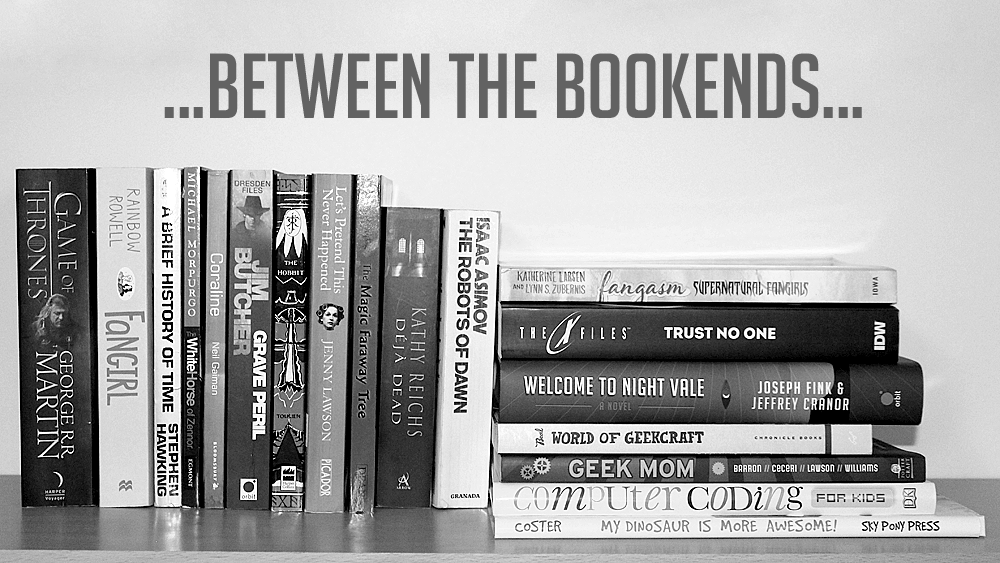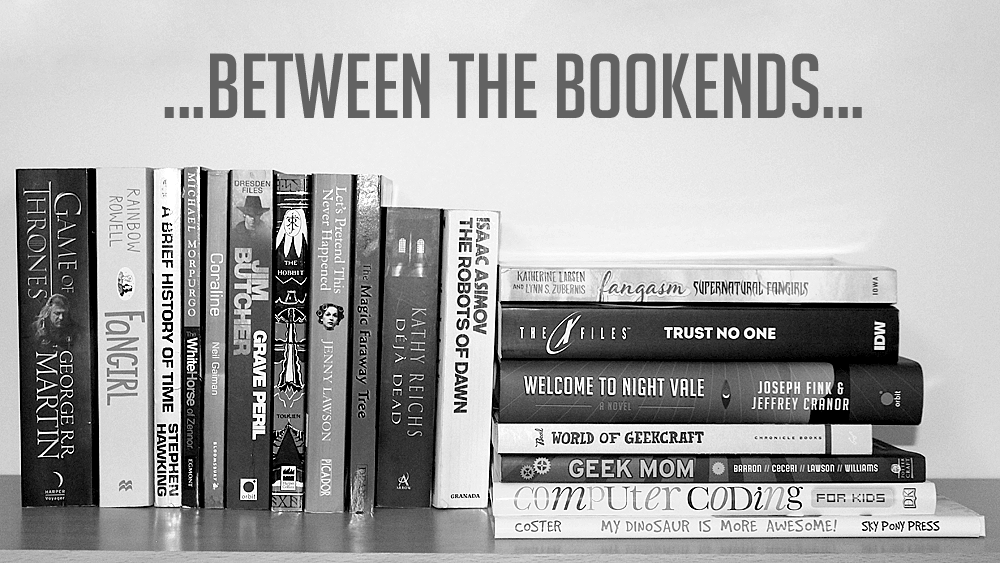
Welcome to this month’s bumper Between the Bookends. If it’s felt like a while since our last post, that’s because we’ve switched dates; Between the Bookends will now be appearing on the first of every month to bring you our latest reading discoveries.
In the May edition, as always, Mel, Nivi, Sophie, Rebecca, and Lisa bring you twelve books from a wide range of genres and styles. We hope you find something fun to inspire, educate, and entertain you.

Braving the Wilderness: The Quest for True Belonging and the Courage to Stand Alone by Brené Brown
Mel is a huge fan of Brené Brown ever since listening to Brené’s TED talk “The Power of Vulnerability”. However, this is the first book of Brené’s that Mel listened to via Audible (narrated by the author). Just going off the title, Mel assumed this was a book about self-discovery and how to trust that one has the strength to stick to one’s core beliefs when challenged by physical/mental obstacles in life.
In a way, Braving the Wilderness was all of those things, BUT the wilderness is more symbolic of the conflict within the U.S.’s current political and sociological atmosphere.
This book left Mel conflicted. Each chapter seems to build upon one another, but the cohesion feels ridged, causing the message to get convoluted. Mel felt distracted for most of the book, and she is not sure if her experience is due to a visceral reaction to the narrative or if the conflicts she discovered are truly the issue. Brené’s use of colorful language is one of the things that drew Mel to her work, so, she was surprised that the entire chapter on “Bulls**t” made her feel uncomfortable and distracted from the message. Let’s just say if one played a drinking game and drank a shot every time Brené cursed, death would be imminent. Second, the final chapters had some major similarities to John Eldridge’s book Wild at Heart, minus the political sentiment. It almost felt like her concepts were plucked directly from his work, which was somewhat annoying, because, in retrospect, even the title carries similarities. Is this book meant to be a mirror of his work but with a political twist? Overall there were some great concepts, but this was not as poignant as her TED talks.
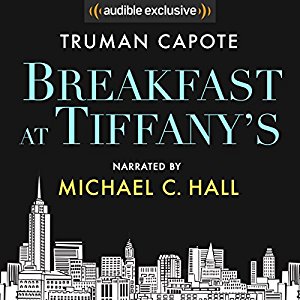
Breakfast at Tiffany’s by Truman Capote (Narrated by Michael C. Hall)
Mel never thought she would say this, but she liked the movie more than the book. She blames Audrey Hepburn for this conundrum, or maybe Mel feels this way because she watched the movie first—she didn’t even know there was a book until recently.
Mel loves a taboo, foul-mouthed character, but she experienced a knee-jerk reaction to Capote’s colorful and racist version of Holly. In the movie, however, Hepburn was the epitome of class and beauty and Hepburn’s Holly is a quirky bubble of lighthearted pleasure. She brought her own brand to the character and it was a success, even though it was nothing like the book.
However, after sitting in contemplation for a bit, Mel was also drawn to Capote’s Holly.
Capote’s novella portrays a darker, guarded, and vulnerable Holly with a story containing some taboo topics and colloquialisms—and Mel is not just referring to the fact that Holly is a high-class prostitute living in divine decadence. Capote’s Holly might not be as accessible as Hepburn’s, but there is a beauty to the brokenness and struggle of Capote’s Holly as she searches for that thing that will set her free.
Breakfast at Tiffany’s is a character-driven novella written in a rich narrative. This is the type of book you savor like a nice cup of coffee on a rainy day, because to breeze through this novella would be an injustice. What makes Capote’s novella intriguing is the portrayal of Holly Golightly. She is impulsive yet sophisticated, defiant but innocent, self-aware yet detached from reality, and dependent upon others’ emotional support while portraying herself as independent. She is a walking contradiction, and that is fascinating. There is nothing traditional or simple about Holly Golightly which is why this novella is a classic.
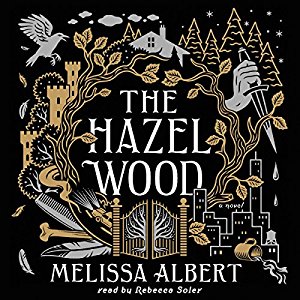
The Hazel Wood by Melissa Albert, Narrated by Rebecca Soler
The book blurb promises more than The Hazel Wood can deliver, and for that reason, Mel was frustrated with this read. One or two issues can be overlooked, but this YA novel has multiple issues which make it difficult to suspend disbelief, even if the concept was intriguing.
This tale follows seventeen-year-old Alice and promises to be a coming-of-age gothic-style fairy tale with similar concepts to Alice in Wonderland. Alice and her mother are nomads, constantly running from an unknown past—ignorance can be bliss. But when Alice’s mother is taken by the characters of The Hinterland, Alice embarks on a journey to discover the truth behind her eccentric grandmother and her grandmother’s cult-classic novel Tales from the Hinterland.
The Hazel Wood felt like two separate stories. Lack of editing and plot structure caused the death of this novel. Alice is an angsty teenage cliché, which can be done right but character development is key. And, fantasy world-building takes time. It must be done with precision so the reader has time to experience the atmosphere with the characters. Alice could have entered The Hinterland by the end of the first quarter of this novel. However, the author spent the first half, maybe longer, of the novel telling the reader about The Hinterland from a book within the story, only to enter The Hinterland after the reader is half-way through the novel. Why?
Finally, the purple prose was the only thing that exceeded Mel’s tolerance level. Normally, Mel can overlook purple prose in a YA novel, but in conjunction with the other issues, Mel was overwhelmed with how much she was expected to overlook in order to suspend disbelief and enjoy this novel. The only saving grace was the retelling of the stories within Tales from the Hinterland.
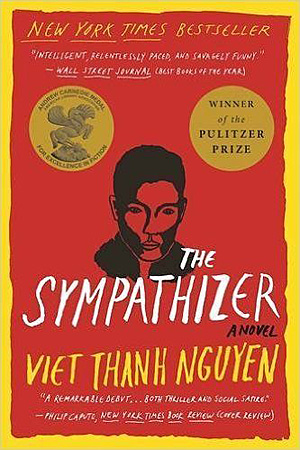
The Sympathizer by Viet Thanh Nguyen
When Nivi reads critically acclaimed books, she tends to read pretty closely. After all, having read many books, she wants to get a sense of what makes that particular book stand out as award-worthy [full disclosure: there was definitely jealousy at play]. So her guard was up as she started reading Pulitzer Prize winner The Sympathizer by Viet Thanh Nguyen for book club.
Set in the years after the fall of Saigon at the end of the Vietnam War, the novel follows the life, struggles, and challenges of the half-Vietnamese, half-French Communist double agent spy narrator. It is a story of friendship, allegiance, betrayal, and war. It’s about knowledge versus belief, good versus evil, education versus brainwashing.
Structurally, the novel shifts from scene to scene, between past and present, from Vietnam to America, from exposition to dialog and back again, all without changing form (no quotation marks anywhere). It takes some getting used to, but it isn’t too disruptive to the experience. There were moments that felt anachronistic, insights and turns of phrases that felt more 2018 than 1950s, and early on these stuck out like a burr. It dragged, and the narrator was not particularly someone she wanted to follow through so many pages. Nivi stuck with it, and it did get better later, but she didn’t love it. Insights into another time and place are one thing, but she’s not convinced this is the best one out there. Which is a shame.
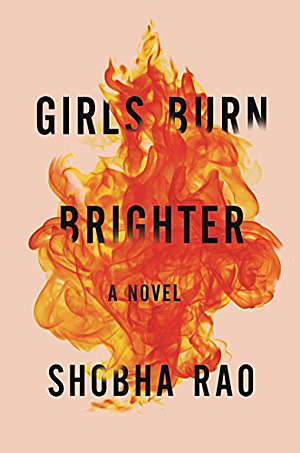
Girls Burn Brighter by Shobha Rao
Girls Burn Brighter is Shobha Rao’s debut novel: a haunting, beautifully-written novel with a compelling heart-wrenching story about two poor girls and the friendship that sustains them.
This novel so poignantly paints a sharp picture of the damage that oppressive cultural views can cause, not just to girls but to entire families. Circumstances—and the misdeeds of others—force the fate of Savitha and Poornima’s lives, and it is these hardships that can either crush the women or strengthen their resolve. If you ever wonder just how much someone can or should be forced to bear, this book details it. There’s a spark of hope that resides in these women, and you can’t help but marvel at it.
The story takes the women from Indravalli to Vijayawada to Seattle, the world around them growing ever larger and their places in them ever narrower. And yet the hope remains.
Narratively, this story is told in an alternating third-person close point of view, shifting between Savitha’s and Poornima’s stories. The time shifts back and forth, overlapping slightly at times, but in an easy-to-follow way. Unfortunately, the close point-of-view structure is limited, so that all information must be filtered through the consciousness and awareness of the character’s mind. For the most part, this holds true, but at one point (Nivi is avoiding spoilers), Savitha’s story shares more information than she could possibly comprehend. Obviously, this is done to convey information to the reader, but the inconsistency is jarring and detracts from the story. It is an unfortunate shortcoming in an otherwise captivating narrative. The ending also seems somewhat rushed and seems to end just a little too soon (leaving many questions unanswered, perhaps hinting at a sequel). Still, worth it.
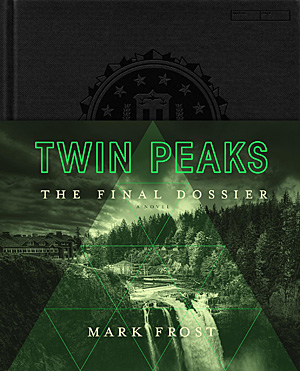
Twin Peaks: The Final Dossier by Mark Frost
Sophie spent much of last summer watching Twin Peaks: the Return. After 18 hour-long episodes that made her laugh, cry, cringe, cheer, and want to hide behind her couch, she found herself almost as clueless about what was going on at the end as she was when she began.
Enter Mark Frost and his stunningly beautiful books. Sophie read the first volume—The Secret History of Twin Peaks—before the new season began and considers it the most important book you can read about the show. Twin Peaks: The Final Dossier, while not as illuminating as its sibling, is nevertheless vital reading for fans.
As with Secret History, Final Dossier is presented as a real object from within the Twin Peaks universe, in this case, a collection of reports written by Agent Tammy Preston. Each report covers a person, people, or place from the show, updating us on their lives through the missing years between the end of the show’s second season in 1991 and today. Naturally, the book includes countless spoilers.
If you’re hoping for clarity from this book, you will walk away disappointed. After all, this is a book from the world of David Lynch where explanations and understanding are effectively nonexistent. Secret History introduced a lot of new information that was barely touched on in The Return (e.g., Doug Milford’s life story) and The Final Dossier doesn’t bring any closure here either. You feel that Frost and Lynch wrote their own versions of modern Twin Peaks and barely consulted one another in the process. Yet somehow, that just adds to the weirdness and charm of it all.
The Final Dossier is obtuse, filled with bizarre anecdotes that won’t help you understand the show (the bit about Neil Young and Jerry Horne turning log cabins into giant speakers being a prime example) and has no satisfying conclusion. For those reasons and more, Sophie highly recommends you read it and take yourself once again to that small town both beautiful and strange.
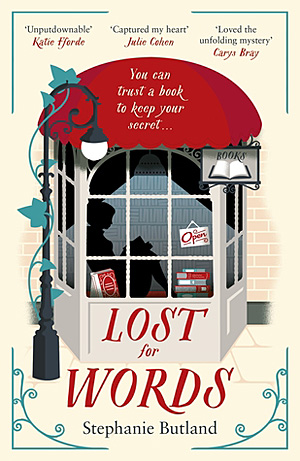
Lost For Words by Stephanie Butland
One of the PopSugar Reading Challenge 2018 prompts is, “a book that involves a bookstore or library,” and it was this which caused Sophie to pick up Lost For Words by Stephanie Butland.
Loveday Cardew works in a second-hand bookstore in York, UK. She is your typical Bookish Female Character With a Tragic Past™; she prefers books to people and has kept her past a secret from everybody in her life. Of course, all this changes when she meets magician and poet Nathan. At the same time, all-too-familiar copies of books from her childhood begin arriving in the store. Loveday soon realizes that somebody is sending her a message that they know about her past, but she doesn’t know who they are or why they are doing this.
The core of the book centers on domestic violence, which has been part of Loveday’s life for longer than she cares to remember. The subject is handled respectfully, and the story offers the opportunity for thought about victims, self-defense, justice, and escaping the cycle, but readers with a personal history may find it hard to read. Despite having such a dark heart, the book manages to remain generally quite light, thanks mostly to Loveday’s boss, mentor, and long-term friend Archie. Archie could be termed the book’s comic relief, but that would be doing him a disservice. He’s a man with a curious history even Loveday isn’t entirely sure about, mostly due to people constantly greeting him with phrases like “Archie! It’s been a long time since Borneo!”, causing Loveday to occasionally wonder if her entire life isn’t a piece of performance art he is orchestrating behind her back. He was by far Sophie’s favorite character.
Lost For Words was a lovely book with a good blend of drama, romance, humor, and a main character with a surprising amount of depth. Perfect for light summer reading in the garden.

Quidditch Through the Ages by J. K. Rowling (as Kennilworthy Whisp), Narrated by Andrew Lincoln
Sophie listened to the new audiobook version of Quidditch Through the Ages by J.K. Rowling with her family over mealtimes. Like with last year’s Fantastic Beasts and Where to Find Them audiobook, this version has been lengthened from the original 2001 Hogwarts Library book. Unlike Fantastic Beasts, however, the additions to Quidditch Through the Ages have not been added subtly.
The book is divided into two parts. Part one is, as far as Sophie can recall, the original book in its entirety with a few new bits scattered in. It is narrated solely by Andrew Lincoln and is as fun and informative as she remembered, charting the fictional history of Quidditch over many hundreds of years, the evolution of the balls and scoring methods, and introducing the most important Quidditch teams and tournaments. The book then ends, complete with a chapter on the charity the book is raising money for, only to begin again with the bulk of the new content.
This second (longer) half is formed almost entirely from the Daily Prophet reports of the 2014 Quidditch World Cup that were uploaded free to Pottermore a few years ago and is narrated by Ginny Potter (Imogen Church) and Rita Skeeter (Annette Badland). Consequentially, this half of the audiobook is mostly narrated reports from all 20 matches during that tournament, and boy does it get repetitive; if Sophie heard the line, “From the Daily Prophet’s Quidditch Correspondent in the Patagonian desert, Ginny Potter” one more time, she was going to start taking hostages. After the introduction, the only break from these match reports are gossip columns from Rita, which, although interesting and clearly written by the Rita that Potter fans all know and hate, were absolutely filled with spoilers for the final books in the series. As Sophie’s son is only up to Order of the Phoenix, they soon gave up on listening as a family until he finishes the series.
Very much a book of two-halves, Sophie would have been content with just the first half of this one and very much doubts she’ll bother listening to the second half again.

Miss Subways by David Duchovny
Finally, Sophie picked up David Duchovny’s latest book, Miss Subways. Although generally rather dubious of celebrities penning books, Sophie hugely enjoyed Duchovny’s previous novel Bucky F*cking Dent (that Masters and partially completed English Literature PhD probably helped him quite a bit) and was hoping for more intimate New York storytelling. Instead, Miss Subways tries to be a mashup of Neverwhere and American Gods but falls short of both.
Emer Gunnels once had a brain tumor that caused her to experience vivid hallucinations. One evening she is approached by a “strange little man” who shows her a video of her boyfriend Cuchulain (the pair are named for figures from Irish folklore) being pushed in front of a car by a woman named Nancy/Anansi whom he met that evening. The man offers Emer the opportunity to save Con’s life but in doing so the world will change, Con and Emer will have never known one another and must never meet. Emer accepts the offer and saves Con’s life, waking up in a new reality with no memories of her old life, but things do not go smoothly from here as Gods and monsters begin entering her life causing her to wonder if her experiences are real, or more hallucinations and the universe seems determined to bring Emer and Con back together.
This was a very weird book. Think elderly people having an orgy in the Central Park reservoir while chanting their allegiance to a Chinese food delivery service God level weird. In fact, Sophie’s favorite line came from one of the sex scenes (all written in the worst kind of 12-year-old fanfiction style): “his lips were like that sci-fi tool in the movie Men in Black that make you forget everything.” True genius.
Sophie couldn’t say she enjoyed it as much as Bucky F*cking Dent, but it’s certainly one of the most bizarre books she’s read in a long while, and sometimes that burst of “WTF am I reading here?” is just what the doctor ordered.
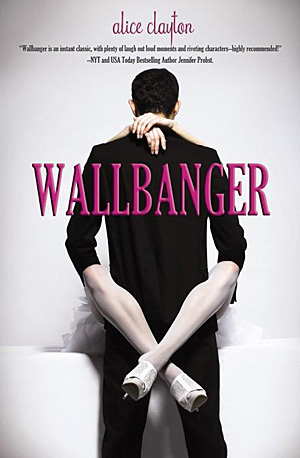
Wallbanger by Alice Clayton
Rebecca is lucky to have a local, independently-owned bookstore. She walked into The Bookhouse the other day and perused their romance section with recommendation cards written by staff. On display, with a lot of exclamation points on the accompanying card, was Wallbanger, a modern romantic comedy. After purchasing it, she spent the majority of her free (and supposed-to-be-working) time reading it. A modern romantic comedy done really well. Half-way through she realized there wasn’t a subplot. No wicked guardians, evil spells, or rabid bears. Just romance. And for 384 pages, Rebecca was entertained. How is this possible?
The premise is gold: Our heroine Caroline is a well-put-together, attractive, successful interior designer. She has a good family, close friends, a successful job she loves, a cuddly cat, and self-esteem. That last part is one of the highlights for Rebecca in this book. Caroline has no problem traveling alone and being alone, in fact, she is quite content. The only thing she is lacking is the ability to orgasm. This book is straight-forward in talking about sex with mature adults. Caroline has had good, safe sex with men in the past, and herself, but one selfish and terrible lover months ago made her currently unable to find the “Big O.”
Enter her neighbor, Simon. She meets him through the sounds of his love-making, loudly, on the other side of her bedroom wall. For three nights with three different woman (that she gives appropriate nicknames per their noises) she is kept awake with their unbelievable orgasms that make her so sexually frustrated and sleep deprived, she bangs on his door in the middle of Number Three until he wrenches it open with only a bed sheet (of course he’s incredibly attractive) and a scowl that quickly turns into a smirk because she happens to be wearing a cute pink nightie. An argument and two slammed doors later, we have our couple. Their flirty banter is fun, and the sexual tension is non-stop. If you’re up for it, Wallbanger will keep you up all night.
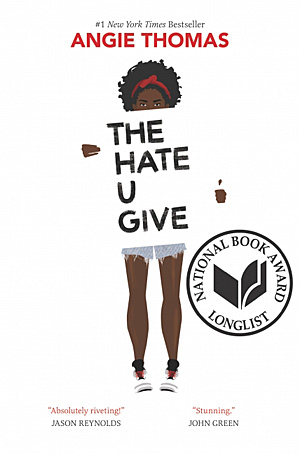
The Hate U Give by Angie Thomas
The Hate U Give by Angie Thomas was the book club pick this month for Rebecca Angel’s group. Wow. Although she completely forgot to get the book until a few days before, she had no problem finishing it in time. It had an engaging plot, strong narrator, complex yet relatable relationships, and a powerful message. Eleven people came to discuss it and unless someone wasn’t speaking up, Rebecca was the most racially diverse. A very white, middle-class group. This is an important fact because their discussion was on the book, but also on race in general. All but one person liked the book.
Although the main plot is about a teen girl witnessing the murder of her childhood friend at the hands of a police officer, much of the book spends time showing her daily life. Starr Carter must move seamlessly between her two worlds: her loving family in the black, lower-class neighborhood she lives, and the friendships and romance in her upper-class, mostly white prep school. As a mother of older children, Rebecca found the friendships, romance, and family dynamics were spot on. The dialogue was often funny even in situations that were not. Teenagers are teenagers no matter what skin or economic class they are in. Most of the people in the group fell in love with the kids in the book.
We talked about our experiences being pulled over by police and how, although worried, we were never afraid for our lives or our children’s. We talked about how hard it is to be a teen without society treating you like shit. And we talked about how we wished our children weren’t reading the out-dated, discussion-killing books they are given in school, and instead were given The Hate U Give to have their own discussions on how to become compassionate activists for positive change in our country.
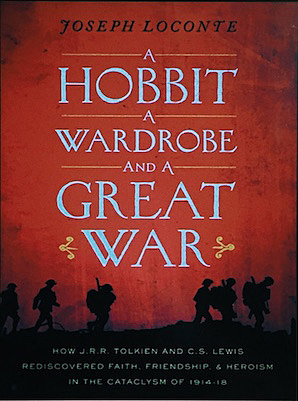
A Hobbit, a Wardrobe, and a Great War: How J.R.R. Tolkien and C.S. Lewis Rediscovered Faith, Friendship, and Heroism in the Cataclysm of 1914-18 by Joseph Loconte
Every spring, Lisa picks out a book on some deeper journey into matters of faith and life to study during the Lent season, and this year she discovered A Hobbit, a Wardrobe, and a Great War: How J.R.R. Tolkien and C.S. Lewis Rediscovered Faith, Friendship, and Heroism in the Cataclysm of 1914-18 by Joseph Loconte. She thought this would be just an enjoyable biography of two authors; instead, she was impressed with the depth of research and history of the entire World War I era, and its devastating effects on Europe and those who served.
The most absorbing chapter dealt with Tolkien’s own experiences as a Second Lieutenant. The horrors and heroism he experienced shaped many of his future writings. The chapter includes small examples of his prose and poetry, and how they were directly influenced by his war experience. With a movie in the works on Tolkien’s life during the Great War, Lisa found this was an ideal book to read in anticipation of it.
The chapter on Lewis and his work was similarly interesting, although Lewis’s journey was very different. Overall, Loconte did a tremendous job reminding readers how each of the endless victims of this war had an entire life of their own before entering the trenches. Readers will gain a new, and often heartbreaking, respect for soldiers, hobbits, and the persistence of the creative mind of a writer.
GeekMom received some items for review purposes.
